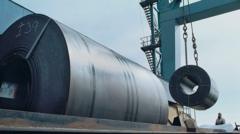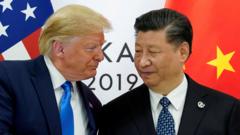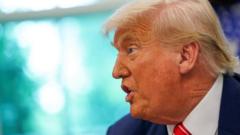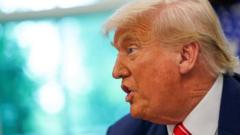**The recent doubling of tariffs on steel and aluminum imports by President Trump to 50% has raised alarms for American businesses and trading partners alike, as manufacturers brace for increased costs and potential market fallout.**
**Trump's Tariff Increase on Metals Sparks Industry Concerns**

**Trump's Tariff Increase on Metals Sparks Industry Concerns**
**President's Signature on 50% Tariffs Leaves Businesses Reeling Amid Economic Strains**
US President Donald Trump has enacted a significant hike in tariffs on steel and aluminum imports, doubling them from 25% to 50%. This move, which took effect on Wednesday, marks the second escalation of import duties since March. Trump asserts that these tariffs are designed to bolster the American steel industry; however, many industry stakeholders caution that the measures could have unintended consequences, including retaliation from foreign countries and increased costs for domestic users of these metals.
In the lead-up to the tariff increase, many affected companies were hopeful that this measure would be temporary or serve as a negotiating tactic. "Always the question with Mr. Trump is whether this is a tactic or a long-term strategy," remarked Rick Huether, the CEO of Independent Can Co., based in Maryland. His company imports steel from Europe to manufacture a variety of products, including decorative containers.
The US, already the world's largest steel importer after the European Union, primarily sources its steel from Canada, Brazil, Mexico, and South Korea. Trump's previous tariffs of 25% on steel and 10% on aluminum were implemented under the guise of national security. While some imported products were previously exempted due to trade negotiations, these exemptions have now been revoked, causing concern among suppliers on the financial implications of these tariffs.
As of May, there has been little change in US steel imports or production rates, though steel imports did dip by 17% in April compared to March. Experts predict that the latest tariff escalation will lead to further declines. Both Canada and the European Union had started preparing countermeasures against American products as a response to earlier tariffs, with trade officials highlighting ongoing discussions in hopes of reaching favorable agreements.
In the UK, the announcement of the 50% tariffs has heightened pressure on government officials to finalize trade deals with the US, particularly to protect UK steel interests from expected tariffs. The UK Trade Secretary expressed satisfaction with their negotiations preserving UK steel from the increased duties, while industry leaders voiced concerns that such tariffs could negatively impact exports to the US and lead to order cancellations.
Economists have cautioned about the broader negative impacts on the US economy, highlighting how rising prices attributed to these tariffs could stifle job growth. Analyses from previous tariff implementations indicated that while a small number of jobs were created in steel production, far more were lost across other industries reliant on these essential materials. With this latest decision, experts worry job losses could be even more pronounced.
Chad Bartusek, who runs a small manufacturing firm in Illinois, shared his distress over the decision. He has faced significant increases in expected tariff costs, which will impact his business operations and workforce hours. Amid rising prices and cautious consumer ordering, he hopes for a return to stability. “It’s one punch after the other,” he added.





















